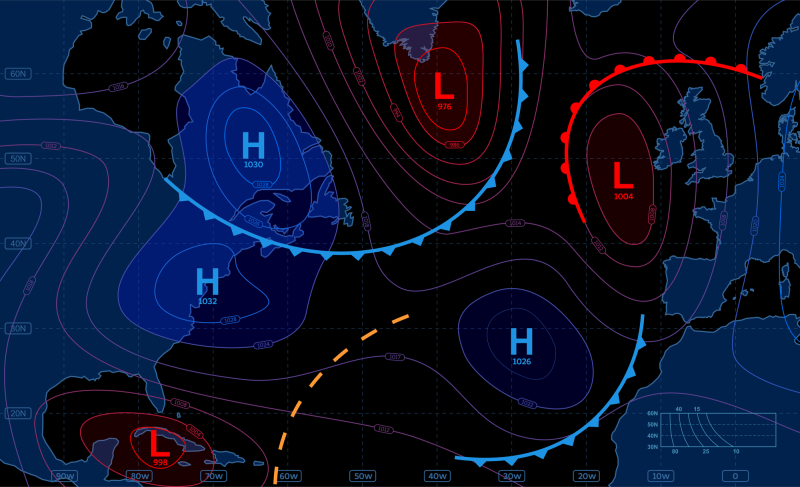Contents:
Chaos as seen by scientists
First, let’s imagine a group of ITMO students. They all started the same educational program, let’s say Theoretical Physics, attended the same lectures, and learned the same things. It'd appear that all these students should become equally proficient physicists. But in fact, each graduate will have a different outcome, owing at the very least to their different starting points: one student opted for physics because of their parents, another – out of passion, and another – by simple mistake. As a result, the first student may decide to launch a startup, the second one – to become a researcher, and the third one – to change their Master’s major. That is, slight differences in students’ starting points lead to drastic ones when it comes to their future paths.
This case is much akin to chaotic dynamical systems. Generally speaking, a dynamical system is a mathematical abstraction that allows scientists to study and describe the evolution of systems in time. It contains a multitude of elements with a given functional dependency of coordinates and velocities. Dynamical chaos, on the other hand, is a phenomenon in the theory of dynamical systems, in which a system’s behavior seems random, though is thoroughly defined by deterministic laws. Remember the students? A high sensitivity to initial conditions is a feature of chaos; even the smallest changes cause significant divergences in the trajectories of elements of a dynamical system.
One example is the weather. It also includes multiple elements described by macroscopic parameters such as atmospheric pressure, cloudiness, air temperature, and some other factors. The evolution of these elements and parameters is extremely sensitive to the starting conditions, and even minimal variations in those can have an impact on the system's overall behavior.
That is why, in the case of students, we will never be able to anticipate exactly what they will become even if they were in the same studying conditions. And if we talk about the weather, we won’t be able to give predictions far into the future. But what we can do is more or less accurately predict occurrences over short periods of time, such as how many students will pass their first exam or what the weather will be like in ten minutes. Should the planning horizon extend, assumptions become no more efficient than Tarot card reading. That’s how chaos is seen by scientists.

Weather map. Credit: belozersky / photogenica.ru
Chaos theory: the beginning
Chaos theory began with Isaac Newton and his laws of motion and universal gravitation. Using Newton’s motion equations, we can predict the behavior of two gravitationally interacting objects (e.g., the Sun and the Earth), if we know their precise position in space and velocity. However, if a third body enters the stage, it complicates the dynamical system and makes it impossible to analyze its evolution. Minor changes in the relative initial position of objects in space and their speed results in varied dynamics of such systems. In one case, the bodies will fly apart, while in another – they will begin to rotate around regular periodic orbits and in the third – they will crash. The divergence of trajectories is a sign of dynamical chaos. The three-body problem was first posed back in 1687, but it has yet to be solved; there are solutions solely for some exceptional cases.
There were also other attempts to test the limits of determinism beyond mathematics and physics. For example, in 1814, mathematician Pierre-Simon Laplace proposed the concept of Laplace's demon – a hypothetical being that knows the position and speed of any particle in the universe with extreme precision and can therefore tell its past and future. However, putting this theory into action proved impossible; creating and storing predictions of that volume would need immense processing power at the time, just as it does now.
More profound chaos studies took place in the second half of the 20th century – and not without the help of technological progress. Computers appeared, which were powerful enough to make complex calculations and produce results at a quicker rate. For one, meteorologist Edward Lorenz made use of these advances: he attempted to describe weather occurrences using a set of three equations, which he then used to simulate atmospheric processes via a computer. After a while, the scientist repeated the calculations and used less precise indicators for the algorithm, rounding them to three decimal places in order to accelerate the process. The researcher expected minor changes in the results, but in reality the output of his second calculations differed significantly.
After analyzing both results, Edward Lorenz concluded that a system of study like the weather is very sensitive to the starting circumstances that influence its future, which makes it impossible to predict the upcoming course of events. As he understood that it’s not feasible to precisely quantify all of the starting circumstances, implying that such systems are essentially unpredictable over time, Edward Lorenz even posed a hypothetical question, “Can the flap of a butterfly's wing in Brazil cause a tornado in Texas?” The phenomenon was named the butterfly effect.

Credit: Dukenod / photogenica.ru
Why study chaos
Chaos theory helps to address fundamental problems that bother humans, such as how predictable the world is and which events we can anticipate and which we cannot. This knowledge we can use, for instance, to advance our weather forecasts (at least for the nearest future), assess the risks of developing heart diseases, or model changes in populations of animals and plants.
For such studies, it’s necessary to understand the principles that cause the transformation of an ordered system into a chaotic one, causing its predictable behavior to become random. As of today, scientists distinguish three main scenarios of a chaotic system development; one of them being the Feigenbaum scenario, or a cascade of bifurcations, which shows how a system turns into a chaos via a series of jump-like complications.
The cascade of bifurcations can be explained using a simple example. Say, there’s a girl named Anna who lives in Moscow. As a school student, she spent each summer at her grandma’s in Tver Oblast. When she got into a university, she started her first job and set aside some money so she could not only visit her grandma, but also travel to St. Petersburg or Abkhazia during her vacation. This road of possibilities is called bifurcation, i.e. a restructuring of the system due to a change in its behavior. Now, when it’s summer, Anna can be at her grandma’s or several other locations.
The next bifurcation will appear when Anna will get a prestigious job, double her income, and will be able to afford four instead of two summer destinations. The more Anna earns, the more locations she can afford – that’s what a cascade of bifurcations is. Now, it is impossible to predict her specific location in summer.
Anna’s trips may appear chaotic, yet they follow certain laws and patterns. Scientists have even been able to determine the pattern of bifurcations. For example, in 1975, mathematician Mitchell Feigenbaum developed numerous constants that were eventually named after him. In general, these indicators can help quantify and predict how and when an ordered system becomes more chaotic. The constants are universal and suitable for diverse chaotic systems.

Credit: toxawww /photogenica.ru
How chaos can affect everyday life
Aside from weather, there are many other chaotic systems that affect our everyday life, including our own heart. A healthy person has an obvious and defined cardiac cycle, but if they suffer from a heart condition, say atrial fibrillation, their heart begins to contract chaotically, beating irregularly. This is similar to the behavior of a chaotic system.
Early detection can help prevent such diseases. One of the solutions is a neural network based on chaos theory that analyzes a patient’s profile and their heart activity to determine if they have the condition.
Chaos theory was also used to describe the behavior of bowhead whales; the method allows for detecting more specific behavior traits than when performed the traditional way, with trackers. For that purpose, researchers tried to see each whale that moves between surfacing and diving as a chaotic oscillator. By analyzing the data, they found that the behavior of whales can synchronize over a distance of several hundred kilometers, much like the pulse of several oscillators. That is possible thanks to the partial synchronization of communication between whales and the impact of the environment.
Chaos studies at ITMO
Researchers from ITMO’s International Research and Educational Center for Physics of Nanostructures also use the principles of chaos theory to solve applied scientific problems; for instance, to determine the size, mass, charge, density, and other parameters of micro- and nanoparticles based on the characteristics of the transition to chaotic motion.

Dmitry Shcherbinin and Semyon Rudyi deliver a pop-sci talk at the library of the Planetarium No. 1. Photo courtesy of the subject
Nanoscale materials can help biovisualize tumors, detect impurities in gasses and liquids, and in some other areas, as well. Each application requires specific particles. To make sure that they have created the right nanomaterial, scientists study the optical and physical characteristics of the particles using microscopes and spectrophotometers. However, these methods are more applicable to studying nanoparticles as groups, not individually.
ITMO scientists utilize an electrodynamic trap to locate and examine single particles. In this device, nanoparticles are exposed to a rapidly oscillating electric field. At low voltages, particles follow the same route; however, as the voltage grows, the nature of the movement changes: particles' dynamics become chaotic, and their trajectories diverge. Thus, scientists can study the particles and examine them individually, depending on the nature of their trajectories' complexity.

A nanoparticle levitates in the center of an electrodynamic trap. Video by Dmitry Shcherbinin





